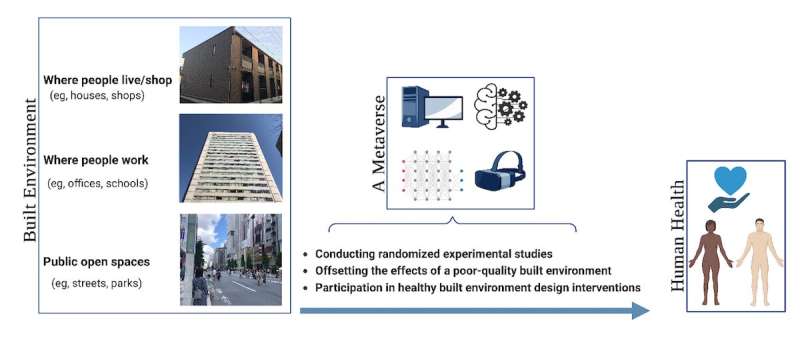The built environment and human health: the opportunities offered by a metaverse (Part of the figure was created with BioRender.com). Credit: Journal of Medical Internet Research (2023). DOI: 10.2196/43549
The "metaverse" has captured the public imagination as a world of limitless possibilities that can influence all aspects of life. Discussions about the utility of completely immersible virtual environments were initially limited to a small number of tech and Sci-Fi circles until the rebranding of Facebook as "Meta" in 2021. The concept of the metaverse has gained a lot of attention since then, and researchers are now starting to explore ways in which virtual environments can be used to improve scientific and health research.
What are the key opportunities and uncertainties in the metaverse that can help us better manage non-communicable diseases? This is the subject of a paper recently published in the Journal of Medical Internet Research, by Associate Professor Javad Koohsari (primary author) from the School of Knowledge Science at Japan Advanced Institute of Science and Technology (JAIST) and colleagues. The team lists three ways in which the metaverse might potentially be used for large-scale health interventions targeting non-communicable diseases.
Non-communicable diseases like diabetes, heart disease, strokes, chronic respiratory disease, cancers, and mental illness are greatly influenced by the "built environment," i.e., the human-made surroundings we constantly interact with. Built environments can affect health directly through acute effects like pollution or indirectly, by influencing physical activity, sedentary behavior, diet and sleep. Therefore, health interventions that modify built environments can be used to reduce the health burden of non-communicable diseases.
This is where the metaverse can be of assistance. Experiments conducted in virtual settings within the metaverse can be used to investigate the effectiveness of large-scale interventions before they are implemented, saving time and money.
"Within a metaverse, study participants could be randomized to experience different built environment exposures such as high and low density, high and low walkability, or different levels of nature or urban environments," explains Prof. Koohsari. "This article will be of particular interest to experts in public health, urban design, epidemiology, medicine, and environmental sciences, especially those considering using the metaverse for research and intervention purposes."
Second, the article notes that the metaverse itself can be used to implement health interventions. For instance, the metaverse can give people exposure to natural "green" environments even when they have little or no access to these environments in the real world. In this way, the metaverse may reduce the negative mental health effects associated with crowded, stress-inducing environments.
Virtual living spaces and offices within the metaverse can be endlessly customized. Moreover, changes to environments within the metaverse can be implemented with the click of a button. Hence, the metaverse may also offer a virtual space to test new office and built environment designs in real-time. Prof. Koohsari adds, "A metaverse could allow stakeholders to experience, build, and collaboratively modify the proposed changes to the built environment before these interventions are implemented in the physical world."
Although it lists several ways in which the metaverse can transform public health interventions by modifying built environments, the article notes key limitations of the metaverse in simulating the real world. In particular, the current state of the metaverse does now allow for the testing of many human behaviors or their interaction with built environments. In addition, the population of the metaverse may not be representative, as people from economically lower strata have limited access to virtual reality technology.
The article also explores ways in which the metaverse can negatively affect population health. For example, excessive immersion in virtual environments may lead to social isolation, anti-social behaviors, and negative health effects associated with physical inactivity or increased screen time. Finally, the article notes that excess reliance on artificial intelligence may lead to the replication of real-world biases and social inequalities in the virtual world. In conclusion, Prof. Koohsari says, "It is best, sooner rather than later, to face the prospects and challenges that the metaverse can offer to different scientific fields, and in our case, to public health."
More information: Mohammad Javad Koohsari et al, The Metaverse, the Built Environment, and Public Health: Opportunities and Uncertainties, Journal of Medical Internet Research (2023). DOI: 10.2196/43549
Journal information: Journal of Medical Internet Research
Provided by Japan Advanced Institute of Science and Technology
























